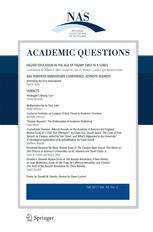John Staddon is James B. Duke Professor Emeritus, Department of Psychology and Neuroscience and Professor of Biology, Duke University. His most recent book is The New Behaviorism: Foundations of Behavioral Science 3rd Edition (Taylor and Francis, 2021). Staddon’s article “The Diversity Dilemma” appears in this issue of Academic Questions.
I used to be skeptical about Richard Dawkins’ meme coinage. After all, meme is just another name for idea.1 But there is a twist. By comparing memes to genes Dawkins emphasized the fact that memes, like genes, spread selectively. Some are more successful than others. The difference, and a weakness in the analogy, is that when a gene increases in frequency we can usually see why. The selective factors at work can usually be identified: faster gazelles survive longer and have more offspring than slower ones: genes for speedy running are favored. The selective factor promoting the spreading of a meme is far from obvious. Why do some ideas—memes—spread more than others?
Here we enter the thickets of social science. Clearly, at any time, some ideas are more successful than others. In science, the hope is that empirical data and logic are the deciding factors. An idea that makes a good argument and survives empirical tests is “fitter” than its competitors. But, as social science has retreated from the model it inherited from physical and biological science, other factors have taken over. The success of a social science claim is no longer dependent on hard data and causal logic.
I will illustrate by looking at a couple of articles by Shinobu Kitayama, 2020 President of the Association for Psychological Science, an organization founded in 1988 “to advance scientific psychology” — in contrast to the already existing American Psychological Association (founded 1892), which was thought to have failed in that regard. (The APA and APS seem now to have converged.)
In the first article, Kitayama describes some animal research which, I will argue, illustrates how human social science should work. The second article, which discusses the touchy topic of systemic racism, shows just how far social science has departed from this approach, advancing conclusions that are socially conformist but scientifically worthless.
Macaque Culture
In his Presidential Column2 of January 6, 2021, entitled “Perspectives and the Truth: Another Case for Diversity and Inclusion” Kitayama describes a study which is “now credited as one of the first indications that nonhuman animals have cultural and social (as opposed to genetic) modes of transmitting behaviors.” The study3 showed that Japanese macaque monkeys on the island of Koshima had learned to wash and eat sweet potatoes. Kitayama contrasts two interpretations of these results, “individualist” and “cultural”
Upon their original discovery, Japanese primatologists saw a macaque community connected by kinship ties. Once one of the members washed a potato, the behavior spread through those social ties . . . Looking at the same scene, however, Western researchers saw something entirely different. They saw each animal receive a series of reinforcements from its environment—reinforcements that enabled the monkey to acquire the behavior. The behavior, in other words, was a matter of individual learning . . . many Western scholars fiercely opposed and even ridiculed the Japanese primatologists for their anthropomorphism. . . . It took several decades for the field to recognize that ‘animal culture’ exists.
Kitayama’s simplified account is a useful starting point to illustrate the difference between two ways of explaining a social phenomenon. One way looks to what one might call “higher-order” causation, like “culture.” The other, which Kitayama calls “individualistic,” begins with proximal causes, the behavior of individual subjects.
There are in fact problems with both these accounts. “Culture” accounts often seem to explain a phenomenon simply by labelling it “cultural,” but leave unanswered how culture is to be measured. The “individualist” account is also deficient. In order to reinforce (reward) an activity, it must first occur or be “emitted,” in the jargon of the field. Once an activity occurs and is reinforced it is likely to recur. But an animal may not emit the “correct” activity so may fail to get a reward and fail to learn the new skill. Or, it may emit the activity, yet the reward may not work (if you reward a little dog for barking, she may well bark less rather than more, for example): not all activities are equally reinforceable. Finally, one monkey may learn to wash potatoes, but fail to communicate this skill to others.
These uncertainties can all be resolved by suitable experiments. The individualistic reinforcement account is correct in one way: macaques do like sweet potatoes, and can learn to wash them. But that does not explain why washing spreads. The account may be rescued by experiments that show macaques have a tendency to imitate one another. So it may only have taken one or two innovators to learn the benefits of potato washing for the tendency to spread. The cultural account may be further strengthened if we find that an animal is more likely to notice and imitate a relative than a nonrelative. In this case, two incomplete accounts can be reconciled by looking for the actual causes of the behavior of interest. The unmeasurable “animal culture” survives, not as an explanation, but as a label for a now-identified set of causal mechanisms. This is how science should work.
But science may also move in the direction favored by Kitayama: away from individualistic accounts towards the scientifically anemic but emotionally satisfying idea of “culture” as a cause. The social science “selection environment” may well favor abstract memes, like “culture” or “systemic racism,” over tough-to-prove causal accounts, like the selective imitation of rewarded potato washing by the macaques. Giving a label to a phenomenon you don’t understand is helpful only if it is followed by an effort to unravel its real causes.
Magic Memes Rule
But much of the social sciences do little unravelling. Instead, labels are simply equated to causes. A 2020 article of Kitayama’s entitled “What is Systemic About Systemic Racism?” illustrates the problem.4 The article promised to provide a scientific treatment for this elusive concept that is missing from most other writing on the topic. The article begins:
While racism surely is in the heads of people who espouse racist ideologies, these ideologies are also inscribed into our daily social interactions. They are woven into the policies and practices of our criminal justice institutions. They are entrenched in institutions of employment, education, finance, housing, and health. Through this ongoing social process, racist ideas and practices are shared, if often implicitly and subconsciously, among most of us in society . . . Until George Floyd was killed, the fact that an implicit White supremacy structures American society did not enter the consciousness of a majority of Americans. [emphases added]
This passage may count as poetry but falls far short of a scientific account. What do phrases such as “inscribed into our daily interactions” or “entrenched in institutions of employment, education” mean? How do we know that “an implicit White supremacy structures American society”? The closest Kitayama comes to an actual definition of systemic racism is this:
[P]overty in minority enclaves precipitates a shortage of all sorts of resources, from medical and social services to healthy foods. Moreover, during the pandemic, residents of poor areas often have no choice but to expose themselves to infection risks at workplaces. Collectively, these realities also add to the systemic racism . . . in America and contribute to disproportionate deaths during the pandemic in these areas. [emphasis added]
Yes, low income obviously limits choices of diet, health care, housing, etc., but what role, if any, does race play in being poor? Poverty has its causes: what are they? They are usually assumed to be different for blacks than whites because of “the legacy of slavery, segregation, discrimination, and a pervasive anti-Blackness.” But how does slavery, a system that ended 156 years ago, and segregation, a system that ended roughly seventy years ago, affect black people today—especially as some important things, like the proportion of black kids born into two-parent families, have actually gotten worse since 1950? Kitayama doesn’t inquire, leaving the reader with the impression that blacks are condemned to exist in an environment that is determined by their history and entirely out of their control—systemically racist: they “have no choice.”
Perhaps systemic racism is just a handy name for a set of causal effects, as in the macaque example? But for the term to be more than an incantation, these effects must be demonstrated. Moreover, to show real racism, the data must show that blacks are treated differently than whites. It is not enough to show that their life situation is different or even that they behave differently than whites. It is simply wrong to assume that any and all black-white disparity is evidence of racism.
Health and Wealth
Kitayama is interested in the putative health effects of systemic racism. To this end he draws on a 2001 article by prominent Harvard sociologist David Williams titled “Racial residential segregation: a fundamental cause of racial disparities in health.”5 Williams and co-author Chiquita Collins begin their article with an unproved anti-white allegation: Racial segregation “is an institutional mechanism of racism that was designed to protect whites from social interaction with blacks . . . [and] is a primary cause of racial differences in socioeconomic status (SES) . . . .” Their use of the term “segregation” is also tendentious because the word implies enforced or legal separation of people (“enforced residence” in their words), rather than voluntary choice, subject to historical and other constraints (affordability, proximity to work, congeniality of neighbors, etc.). Enforced separation has been illegal in the U.S. since 1968. No doubt contemporary housing patterns to some extent reflect their segregated starting point. Nevertheless, it is prejudicial to write, even in 2001 much less 2021, as if actual segregation still exists.
Williams and Collins are ambitious. They argue for a two-step process in a social context where even one step is hard to prove. Nevertheless, they claim that racial residential segregation leads to racial wealth disparities which leads to health disparities. Segregation, by their measure, does covary with poverty. They also found an inverse correlation between wealth, measured, possibly inaccurately, by a Census Bureau survey—you don’t document wealth on your tax return—and measures of health. In each case, one abstraction, “segregation” or wealth disparities, is claimed to cause another, wealth or health disparities.
It is almost impossible to prove a causal connection between two abstractions; nor is covariation the same as causation. Neither is a problem for much of sociology, where abstraction is favored over the actions of individuals, and correlation and cause are routinely equated. Because they are correlated, “segregation” is assumed to cause poverty, low wealth is assumed to cause health deficiencies. The direction of causation is also assumed: segregation causes poverty, rather than the reverse; and similarly poor health may produce poverty. These alternative possibilities (as well as the third: segregation and poverty are both caused by something else) go unexamined. Temporal order is also ignored. After all, sickness now may well lead to poverty next year or the years after. Poverty now may lead to “segregation” later, and so on. Order matters. Williams’s sweeping conclusion is completely unwarranted.
Wealth has no agency and unless the physical environment is toxic, neither does location. What matters is how people behave. Wealth depends not just on available opportunities but also on the interests and abilities of individuals, not to mention luck. Health depends on individual biological susceptibilities as well as behavior and the constraints to which it is subject. But human behavior, not to mention human biology, is completely omitted from Williams’s account. Apart from Williams’s attribution of sinister motives to whites (also undocumented), individual human agency is totally ignored. The minority population is treated like a badly maintained herd of domestic animals, rather than a community of responsible, behaving individuals.
The causal claims of this widely cited article are without any foundation. But “racial disparities” are the problem du jour and “systemic racism” is a successful meme in the contemporary social science zeitgeist, so Williams’s baseless conclusion is embraced by Kitayama.
The APS President’s article is no more than an opinion piece dressed up as science. The opinion is fashionable and from a respected source, but the facts are fragmentary, uncertain, and in many cases ambiguous; the causal claims are totally without foundation. All in all, a very bad day for behavioral science and a probable disaster for policymakers unwise enough to pay any attention to it.
1 The definition has evolved since 1976, in response to social media and the easy sharing of images: https://en.wikipedia.org/wiki/Meme; https://www.nature.com/articles/529462a.pdf
2 APS Observer, January 26, 2021.
3 See the excellent accounts in S. Hirata, K. Watanabe, K. Masao, “Sweet-potato washing” revisited in T. Matsuzawa, ed., Primate Origins of Human Cognition and Behavior, Springer Japan, 487–508, https://doi.org/10.1007/978-4-431-09423-4_24.
4 APS Observer, November 30, 2020.
5 D. R. Williams, C. Collins, “Racial residential segregation: a fundamental cause of racial disparities in health,” Public Health Rep 116, no. 5 (Sep.-Oct., 2001): 404–416, doi: 10.1093/phr/116.5.404.
John Staddon, ''The Devolution of Psychological Science: Memes, Culture, and Systemic Racism,'' Academic Questions 34, no. 3 (Fall 2021). https://www.nas.org/academic-questions/34/3/the-devolution-of-psychological-science-memes-culture-and-systemic-racism.
Photo by Bret Kavanaugh on Unsplash













